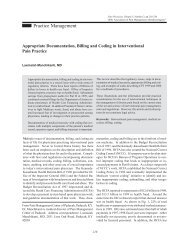ASIPP Practice Guidelines - Pain Physician
ASIPP Practice Guidelines - Pain Physician
ASIPP Practice Guidelines - Pain Physician
Create successful ePaper yourself
Turn your PDF publications into a flip-book with our unique Google optimized e-Paper software.
Manchikanti et al • <strong>ASIPP</strong> <strong>Practice</strong> <strong>Guidelines</strong><br />
32<br />
Kingdom, three times more common than in Sweden, and<br />
two times more common than in Finland. They also noted<br />
up to 15-fold variations across regions of the United States.<br />
Multiple studies evaluating surgical treatment of lumbar<br />
disc prolapse and degenerative lumbar disc disease have<br />
shown conflicting evidence on the effectiveness of surgical<br />
discectomy for lumbar disc prolapse (290, 291, 293).<br />
Evidence is limited and contradictory for automated percutaneous<br />
discectomy (290), with no acceptable evidence<br />
on the effectiveness of any form of fusion for back pain or<br />
instability (290), no acceptable evidence on the efficacy<br />
of any form of decompression for degenerative lumbar disc<br />
disease or spinal stenosis (290), and no evidence as to<br />
whether any form of surgery for degenerative lumbar disc<br />
disease is effective in returning patients to work (290).<br />
The sacroiliac joint, which receives its innervation from<br />
lumbosacral roots, is alleged to be a source of back pain or<br />
referred pain; and prevalence has been shown to be 19%<br />
to 30% in selected population groups (191, 192). The exact<br />
incidence of pain emanating from atlantoaxial and<br />
atlantooccipital, and thoracic facet joints is not known (294-<br />
299). A multitude of other spinal conditions including,<br />
degenerative disorders and myofascial syndromes, contribute<br />
approximately to 5 to 10% of the spinal pain (163,<br />
164, 171, 172, 186-190, 300-304).<br />
Causes of nonspinal pain include the various causes responsible<br />
for headache; trigeminal neuralgia with facial<br />
pain; cancer pain with involvement of various musculoskeletal<br />
structures, either with the spread of the cancer into<br />
bones and muscles, with compression of the spinal cord,<br />
or pain after multiple surgical procedures radiotherapy or<br />
chemotherapy interventions; pain secondary to pressure on<br />
various nerve plexuses resulting in neuropathic pain; and,<br />
finally, pain resulting from visceral organs. Other causes<br />
include reflex sympathetic dystrophy and causalgia or complex<br />
regional pain syndromes Types I and II; postherpetic<br />
neuralgia, phantom limb pain; and finally, the controversial<br />
myofascial pain (171, 172, 186-215). Even though<br />
some prevalence studies have been published occasionally,<br />
there are no controlled or systematic studies to show<br />
the prevalence of various disorders resulting in chronic<br />
pain.<br />
EVALUATION<br />
Appropriate history, physical examination, and medical<br />
decision making from the initial evaluation of a patient’s<br />
presenting symptoms. A patient’s evaluation should not<br />
only meet all the required medical criteria but also meet<br />
the regulatory requirements (305). The guidelines of the<br />
Health Care Financing Administration (HCFA) provide<br />
various criteria for five levels of services. The three crucial<br />
components of evaluation and management services<br />
are: history, physical examination, and medical decision<br />
making. Other components include: counseling, coordination<br />
of care, nature of presenting problem, and time.<br />
AHCPR <strong>Guidelines</strong> for managing acute low back problems<br />
in adults (28) also have provided guidance on initial<br />
clinical assessment, assessment of psychosocial factors,<br />
imaging techniques, and assessment with electromyography<br />
and nerve conduction. While there are numerous techniques<br />
to evaluate a chronic pain patient, variable from<br />
physician to physician and text book to text book, following<br />
the guidelines established by HCFA not only will assist<br />
a physician in performing a comprehensive and complete<br />
evaluation but also assist them to be in compliance<br />
with regulations.<br />
History<br />
The history includes:<br />
♦<br />
♦<br />
♦<br />
♦<br />
Chief complaint,<br />
History of present illness,<br />
Review of systems, and,<br />
Past, family, and/or social history.<br />
Chief Complaint: The chief complaint is a concise statement<br />
describing the symptom, problem, condition, diagnosis,<br />
or other factor that is the reason for the encounter,<br />
usually stated in the patient’s words.<br />
History of Present Illness: The history of present illness<br />
is a chronological description of the development of the<br />
patient’s present illness from the first sign and/or symptom.<br />
It includes the following elements:<br />
♦<br />
♦<br />
♦<br />
♦<br />
♦<br />
♦<br />
♦<br />
Location,<br />
Quality,<br />
Severity,<br />
Duration, timing,<br />
Context,<br />
Modifying factors, and<br />
Associated signs and symptoms.<br />
Review of Systems: The review of systems is an inventory<br />
of body systems obtained through a series of questions<br />
seeking to identify signs and/or symptoms that the patient<br />
may be experiencing or has experienced.<br />
Past, Family, and/or Social History: The past, family,<br />
<strong>Pain</strong> <strong>Physician</strong> Vol. 4, No. 1, 2001
















